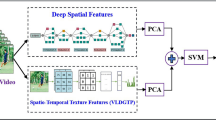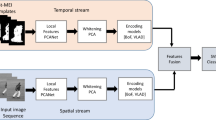Abstract
Human Action Recognition (HAR) has been a prominent area of research within machine learning over the last few decades. Its applications span domains such as visual surveillance, robotics, and pedestrian detection. Despite the numerous techniques introduced by computer vision researchers to address HAR, persistent challenges include dealing with redundant features and computational cost. This paper specifically addresses the challenge of silhouette-based human activity recognition. While previous research on silhouette-based HAR has predominantly focused on recognition from a singular perspective, the aspect of view invariance has often been overlooked. This paper presents a novel framework that aims to achieve view-invariant Human Action Recognition. The proposed approach integrates a pre-processing stage based on the extraction of multiple 2D Differential History Binary Motions (DHBMs) from spatio-temporal frames capturing human motion. These multi-batch DHBMs are then used to capture and analyse human behaviour using the Decimal Descriptor Pattern (DDP) approach. This strategy enhances the extraction of intricate details from image data, contributing to a more robust HAR methodology. The selected features are processed by the Sparse Stacked Auto-encoder (SSAE), a representative of deep learning methods, to provide effective detection of human activity. The subsequent classification is performed using Softmax. The experiments are conducted on publicly available datasets, namely IXMAS and KTH. The results of the study demonstrate the superior performance of our methodology compared to previous approaches, achieving higher levels of accuracy.
Access this chapter
Tax calculation will be finalised at checkout
Purchases are for personal use only
Similar content being viewed by others
References
Zhang, S., Wei, Z., Nie, J., Huang, L., Wang, S., Li, Z.: A review on human activity recognition using vision-based method. J. Healthc. Eng. 2017, 3090343 (2017)
Bhola, G., Vishwakarma, D.K.: A review of vision-based indoor HAR: state-of-the-art, challenges, and future prospects. Multimedia Tools and Applications 83(1), 1965–2005 (2024)
Zebari, R., Abdulazeez, A., Zeebaree, D., Zebari, D., Saeed, J.: A comprehensive review of dimensionality reduction techniques for feature selection and feature extraction. J. Appli. Sci. Technolo. Trends 1(2), 56–70 (2020)
Wu, D.; Sharma, N.; Blumenstein, M.: Recent advances in video-based human action recognition using deep learning: A review. In: Proceedings of the 2017 International Joint Conference on Neural Networks (IJCNN), Anchorage, AK, USA, 14–19 May 2017, pp. 2865–2872 (2017)
Sargano, A.B., et al.: Human action recognition using transfer learning with deep representations. In: International Joint Conference on Neural Network (IJCNN), pp. 463–469 (2017)
Mathe,E., et al.: A deep learning approach for human action recognition using skeletal information. In: GeNeDis, P. V. (ed.), pp. 105–114 (2018)
Zhang, Z., Lv, Z., Gan, C., Zhu, Q.: Human action recognition using convolutional LSTM and fully-connected LSTM with different attentions. Neurocomputing 410, 304–316 (2020)
Mukherjee, D., et al.: EnsemConvNet: a deep learning approach for human activity recognition using smartphone sensors for healthcare applications. Multimedia Tools Appl. 79 (2020)
Dai, C., Liu, X., Lai, J.: Human action recognition using two-stream attention based LSTM networks. Appl. Soft Comput. 86, 105820 (2020)
Khan, M.A., et al.: Emergence of a novel coronavirus, severe acute respiratory syndrome coronavirus 2: biology and therapeutic options. J. Clin. Microbiol. 58(5) (2020)
Nabati, M., Navidan, H., Shahbazian, R., Ghorashi, S.A., Windridge, D.: Using synthetic data to enhance the accuracy of fingerprint-based localization: A Deep Learning Approach. IEEE Sensors Lett. 2020(4), 6000204 (2020)
Chahoushi, M., Nabati, M., Asvadi, R., Ghorashi, S.A.: CSI-Based human activity recognition using multi-input multi-output autoencoder and fine-tuning. Sensors 23(7), 3591 (2023)
Cheng, X., Huang, B., Zong, J.: Device-free human activity recognition based on GMM-HMM using channel state information. IEEE Access 9, 76592–76601 (2021)
Gnouma, M., Ejbali, R., Zaied, M.: A temporal human activity recognition based on stacked auto encoder and extreme learning machine. In: 2023 9th International Conference on Control, Decision and Information Technologies (CoDIT), pp. 1571–1576. IEEE (2023)
Yahia, S., Salem, Y.B., Abdelkrim, M.N.: Texture analysis of magnetic resonance brain images to assess multiple sclerosis lesions. Multimed. Tools Appl. 77(23), 30769–30789 (2018)
Yahia, S, Yassine, B.S., Abdelktim Naceur, A.M.: Multiple sclerosis lesions detection from noisy magnetic resonance brain images tissue. In: International Multi-Conference on Systems, Signals & Devices (SSD), pp. 240–245. IEEE (2018)
Youbi, Z., Boubchir, L., Boukrouche, A.: Human ear recognition based on local multi-scale LBP features with city-block distance. Multimedia Tools Appli. 78, 14425–14441 (2019)
Gnouma, M., Ladjailia, A., Ejbali, R., Zaied, M.: Stacked sparse autoencoder and history of binary motion image for human activity recognition. Multimedia Tools Appli. 78(2) (2019)
Shaikh, I.A.K., Krishna, P.V., Biswal, S.G., Kumar, A.S., Baranidharan, S., Singh, K.: Bayesian optimization with stacked sparse autoencoder based cryptocurrency price prediction model. In: 2023 5th International Conference on Smart Systems and Inventive Technology (ICSSIT), pp. 653–658. IEEE (January 2023)
Schuldt, C., Laptev, I., Caputo, B.: Recognizing human actions: A local SVM approach. In: Proc. 17th International Conference on Pattern Recognition ICPR, vol. 3, pp. 32–36. IEEE (2004)
Weinland, D., Ronfard, R., Boyer, E.: Free viewpoint action recognition using motion history volumes. Comput. Vision Image Underst. 104(2–3), 249–257 (2006)
Liu, H., et al.: Study of human action recognition based on improved spatio-temporal features. Human Motion Sensing Recogn. Fuzzy Qualit. Approach, 233–250 (2017)
Chun, S., Lee, C.S.: Human action recognition using histogram of motion intensity and direction from multiple views. IET Comput. Vision 10(4), 250–257 (2016)
Nida, N., Yousaf, M.H., Irtaza, A., Velastin, S.A.: Video augmentation technique for human action recognition using genetic algorithm. ETRI J. 44(2), 327–338 (2022)
Kiran, S., et al.: Multi-layered deep learning features fusion for human action recognition. Comput. Mater. Continua 69(3) (2021)
Malik, N.U.R., Sheikh, U.U., Abu-Bakar, S.A.R., Channa, A.: Multi-view human action recognition using skeleton based-fineknn with extraneous frame scrapping technique. Sensors 23(5), 2745 (2023)
Author information
Authors and Affiliations
Corresponding author
Editor information
Editors and Affiliations
Rights and permissions
Copyright information
© 2024 The Author(s), under exclusive license to Springer Nature Switzerland AG
About this paper
Cite this paper
Gnouma, M., Yahia, S., Ejbali, R., Zaied, M. (2024). Enhanced Activity Recognition Through Joint Utilization of Decimal Descriptors and Temporal Binary Motions. In: Nguyen, N.T., et al. Computational Collective Intelligence. ICCCI 2024. Lecture Notes in Computer Science(), vol 14811. Springer, Cham. https://doi.org/10.1007/978-3-031-70819-0_28
Download citation
DOI: https://doi.org/10.1007/978-3-031-70819-0_28
Published:
Publisher Name: Springer, Cham
Print ISBN: 978-3-031-70818-3
Online ISBN: 978-3-031-70819-0
eBook Packages: Computer ScienceComputer Science (R0)




